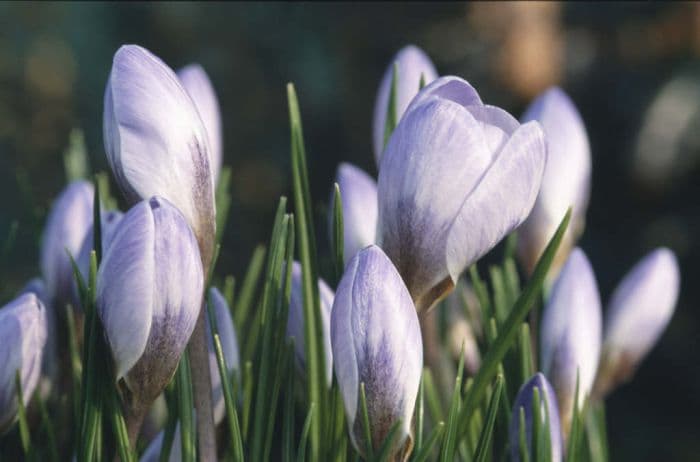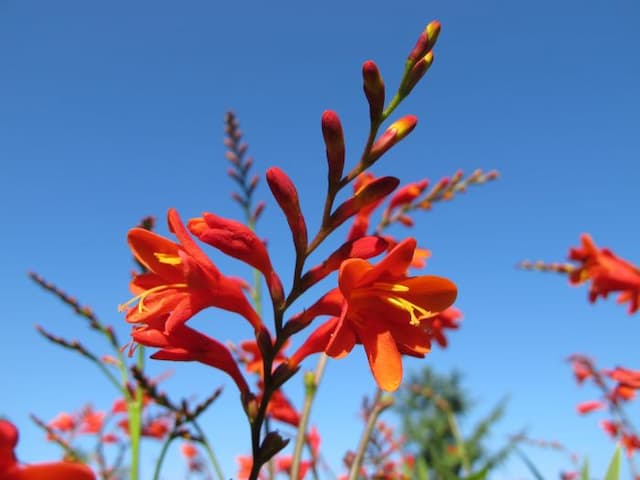Blue Pearl Crocus Crocus biflorus 'Blue Pearl'

ABOUT
The 'Blue Pearl' variety of Crocus bears elegant, chalice-shaped blooms that charm with delicate shades of pale blue and feature a profound cobalt blue stripe running down the center of each petal. The striking contrast is further enhanced by the golden stamens that stand prominently in the center. The soft hues of the flower give it an ethereal presence in the garden. The petals have a silky, almost luminous quality which catches and reflects the light. This crocus variety emerges with slender, grass-like foliage that is glossy and green, often showing a central stripe that is a lighter green or silvery in color. The leaves and flowers arise from corms which are underground storage organs, similar to bulbs. The 'Blue Pearl' crocus heralds the arrival of spring with its blooms often pushing through the last remnants of winter soil, sometimes even poking through snow.
About this plant
 Names
NamesFamily
Iridaceae
Synonyms
Spring Crocus, Two-flowered Crocus, Blue Pearl Crocus
Common names
Crocus weldenii var. sublimis, Crocus sieberi subsp. sublimis, Crocus biflorus subsp. weldenii, Crocus biflorus var. nubigena, Crocus biflorus var. weldenii, Crocus nubigena.
 Toxicity
ToxicityTo humans
Crocus 'Blue Pearl' is not highly toxic to humans, but if ingested in large quantities, it can potentially cause gastrointestinal discomfort, including nausea, vomiting, and diarrhea. It is always advisable to avoid ingesting any parts of ornamental plants due to the uncertainty of their effects and the possible presence of pesticides or other chemicals.
To pets
Crocus 'Blue Pearl' can be toxic to pets if ingested, particularly to cats and dogs. Ingesting the corms can lead to symptoms such as vomiting, diarrhea, and possibly more severe reactions like internal bleeding, respiratory failure, and liver and kidney damage. If you suspect your pet has consumed part of a 'Blue Pearl' crocus, contact a veterinarian promptly.
 Characteristics
CharacteristicsLife cycle
Perennials
Foliage type
Deciduous
Color of leaves
Green
Flower color
Lavender
Height
4 inches [10 cm]
Spread
3 inches [7.5 cm]
Plant type
Bulb
Hardiness zones
3
Native area
Mediterranean
Benefits
 General Benefits
General Benefits- Early Spring Blooming: Crocus 'Blue Pearl' provides vibrant color early in the season, often when little else is in bloom.
- Landscape Beautification: With its beautiful blue petals and contrasting yellow stamens, it adds aesthetic appeal to gardens and landscapes.
- Low Maintenance: It is known to be a low-maintenance plant, requiring minimal care once established.
- Drought Tolerant: Once established, it can tolerate periods of dryness, making it suitable for drier climates or water-wise gardens.
- Naturalizing: It has the ability to spread and naturalize over time, creating larger displays each year.
- Pollinator Attraction: It attracts bees and other pollinators early in the season, supporting local ecosystems.
- Cold Hardy: It is capable of withstanding cold temperatures and is suitable for planting in various climates.
- Compact Size: Due to its small size, it is ideal for planting in rock gardens, borders, or as ground cover in small spaces.
 Medical Properties
Medical PropertiesThis plant is not used for medical purposes.
 Air-purifying Qualities
Air-purifying QualitiesThis plant is not specifically known for air purifying qualities.
 Other Uses
Other Uses- Crocus biflorus 'Blue Pearl', often called Blue Pearl crocus, can be used in crafting natural dyes, with the petals providing a range of possible colors due to their pigments.
- The plant can be part of educational projects in schools to help students learn about plant biology and the lifecycle of bulbous plants.
- It can be used in culinary presentations as an edible garnish, though it is not commonly eaten and should be used sparingly only after ensuring it is safe for consumption.
- Blue Pearl crocus can be used in photographic projects for its aesthetic appeal, especially in macros and nature photography.
- You can also use the dried petals in potpourri mixtures to add a subtle scent and visual variety.
- These plants can be used as a living mulch in orchards or vineyards, where they can help suppress weeds when planted densely.
- Crocus biflorus 'Blue Pearl' can act as an indicator of the changing seasons in a phenological garden, where the timing of its flowering provides ecological data.
- The plant's bulbs can be used in a weight and balance study in science classes, as their uniformity lends to experiments in mass measurement and density.
- Artists may use the crushed petals as a pigment for watercolor or other natural paints in their artworks.
- In perfumery, although not common, the subtle fragrance of Blue Pearl crocus flowers could inspire scent compositions or be used in homemade fragrances.
Interesting Facts
 Feng Shui
Feng ShuiThe Crocus is not used in Feng Shui practice.
 Zodiac Sign Compitability
Zodiac Sign CompitabilityThe Crocus is not used in astrology practice.
 Plant Symbolism
Plant Symbolism- Hope: Crocuses, including 'Blue Pearl', often bloom at the end of winter, signifying the hope and promise of spring and warmer days ahead.
- Youthful gladness: The bright and early blooms of the Crocus 'Blue Pearl' are associated with the joy and innocence of youth.
- Attachment: Given their propensity to return year after year, crocuses can symbolize attachment and the enduring nature of relationships.
- Resurrection: Crocuses have a religious symbolism tied to resurrection, as they re-emerge from the ground after being "dead" during the winter.
- Cheerfulness: The cheerful hue of the 'Blue Pearl' crocus can symbolize joy and optimism as one of the first signs of spring.
 Water
WaterThe Twinflowered Crocus requires moderate watering during its growth phase in the spring. It is best to water it with roughly 1 inch of water per week. Ensure the soil is moist but not waterlogged, as excessive moisture can lead to bulb rot. After blooming, when the foliage begins to die back, reduce watering as the plant enters dormancy. Allow the soil to dry out between watering sessions to mimic its natural environment.
 Light
LightTwinflowered Crocus thrives in full sun to partial shade. A spot that receives several hours of direct sunlight in the morning with some afternoon shade would be ideal for this plant. Avoid heavily shaded areas where the crocus might not receive enough light to bloom properly.
 Temperature
TemperatureTwinflowered Crocus is tolerant to a wide range of temperatures, but it prefers cooler conditions during its growth phase. The ideal temperature range is between 35 and 65 degrees Fahrenheit. It can survive minimum temperatures down to around 20 degrees Fahrenheit but should not be exposed to prolonged periods of deep freeze.
 Pruning
PruningPruning the Twinflowered Crocus is not necessary for its health, but you may remove spent flower stems to maintain a tidy appearance. After blooming, allow the leaves to remain until they die back naturally, as this is when the plant is storing energy for the next season. The best time to remove foliage is when it has yellowed and comes away easily with a gentle tug.
 Cleaning
CleaningNot needed
 Soil
SoilBlue Pearl crocus thrives best in well-draining soil that is rich in organic matter, with a slightly acidic to neutral pH of 6.0 to 7.0. A mix of loamy soil with added compost and sand is ideal for ensuring proper drainage and nutrient availability.
 Repotting
RepottingBlue Pearl crocuses are generally repotted every 3 to 4 years or when the clumps become overcrowded. As they are bulbous plants, it's best to divide and repot them after the foliage has died back in late spring or early summer.
 Humidity & Misting
Humidity & MistingBlue Pearl crocuses prefer average to low humidity conditions, similar to their native habitat. Ensuring good air circulation around the plants will help to maintain the optimal humidity levels.
 Suitable locations
Suitable locationsIndoor
Place Blue Pearl crocus in a bright spot with cool temperatures.
Outdoor
Plant in well-drained soil; full sun to partial shade.
Hardiness zone
3-8 USDA
 Life cycle
Life cycleCrocus biflorus 'Blue Pearl', also known as the Silver-striped Crocus, begins its life cycle from a bulb, which lies dormant underground during the summer. In the fall, as temperatures cool, root growth is initiated, and the bulb accumulates resources. Come late winter to early spring, the Silver-striped Crocus produces slender, grass-like leaves and typically violet-blue, flower buds which emerge swiftly and bloom, depending on the climate. Following pollination, which is usually carried out by early spring insects, the flowers produce seed capsules that mature and are released into the soil to potentially germinate and form new bulbs. As the temperatures rise in late spring, the above-ground foliage dies back, and the plant enters a period of dormancy until the cycle restarts in the fall. It’s during this dormant phase that the bulb is at rest and conserving energy for the next growing season.
 Propogation
PropogationPropogation time
Early autumn
The Crocus biflorus 'Blue Pearl', commonly known as the Blue Pearl crocus, is typically propagated through division of corms. The best time to propagate this plant is in the late summer to autumn period, after the foliage has died back and the corms have gone dormant. Gardeners should carefully dig up the corms, gently separate the offsets, which are smaller corms attached to the main one, and then replant them at a depth of about 3 to 4 inches (7.5 to 10 cm) with a spacing of 3 inches (about 7.5 cm) apart. It's important to plant the corms with the pointy end facing up. This method is effective because each corm can potentially produce multiple offsets that can be used for new plants, thereby expanding your crop of the beautiful 'Blue Pearl' crocuses in your garden.








![Montbretia [Little Redhead]](/_next/image?url=https%3A%2F%2Fplants-admin.emdemapps.com%2Fimages%2Fplants%2F%2Fimages%2F604b5635373f8.png&w=640&q=75)
